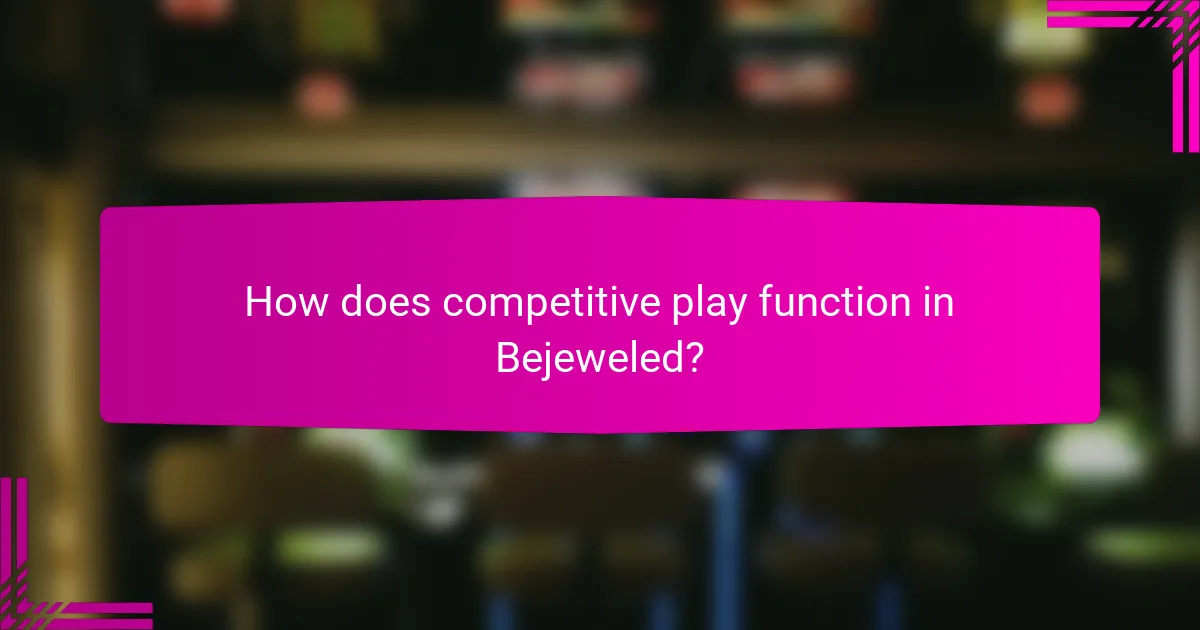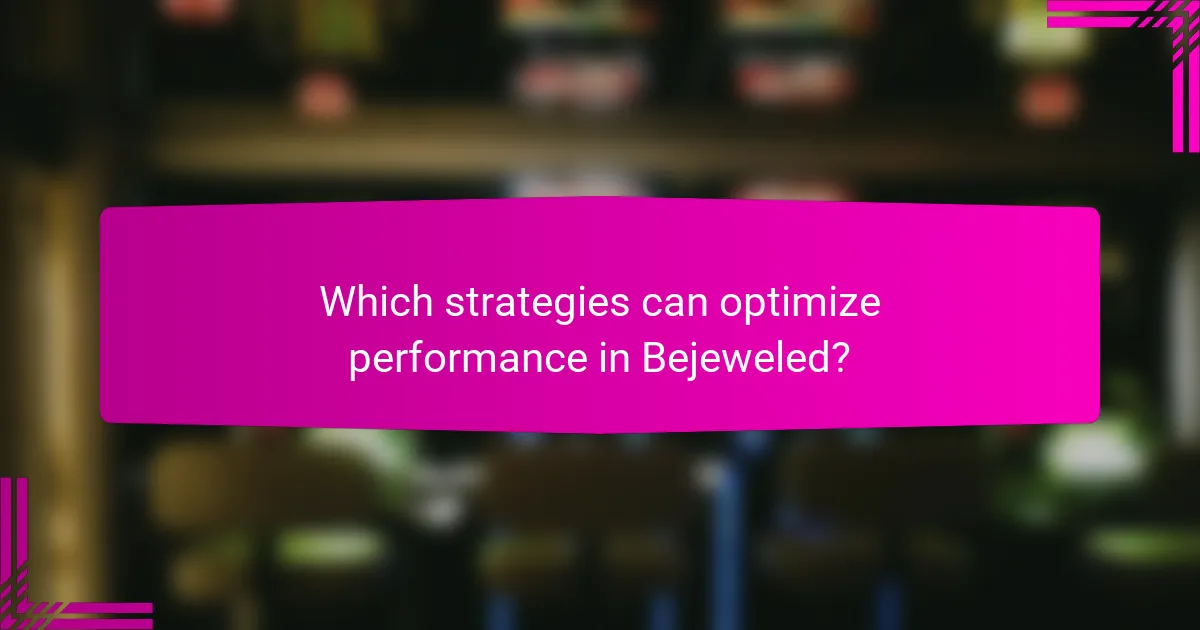Bejeweled captivates players with its engaging match-3 mechanics and competitive gameplay. Explore the core mechanics, popular variants like Bejeweled Classic and Blitz, and the dynamics of competitive play. Discover psychological factors that enhance player engagement and strategies for optimizing performance. Learn how different platforms influence the Bejeweled experience and the challenges players face.

What are the core match-3 mechanics in Bejeweled?
Bejeweled’s core match-3 mechanics involve matching three or more gems of the same colour to clear them from the board. Players swap adjacent gems to create these matches, triggering cascading effects and scoring points. Key attributes include gem types, power-ups, and game modes. Unique mechanics like timed challenges and endless modes enhance gameplay diversity. Rare attributes, such as special gem combinations, provide unique strategies for advanced players.
How do gem swapping and matching work?
Gem swapping and matching in Bejeweled involve exchanging adjacent gems to create lines of three or more identical gems. This mechanic triggers their removal from the board, allowing new gems to fall into place. Players strategise to form combos and utilise power-ups for higher scores. The unique attribute of this game lies in its ability to create cascading effects, enhancing gameplay dynamics.
What are special gems and their effects?
Special gems in Bejeweled enhance gameplay with unique effects. They can trigger powerful cascades or clear entire rows and columns, significantly impacting match-3 mechanics. For example, a flame gem explodes, destroying adjacent gems, while a star gem clears a larger area. These gems introduce strategic depth, making competitive play more dynamic. Players can utilise their effects to create combos, maximising points and advancing levels more efficiently.
How does the scoring system influence gameplay?
The scoring system significantly influences gameplay by determining player strategy and engagement. High scores motivate players to make strategic moves, while bonuses for combos enhance competitive dynamics. This system encourages players to think critically about each match, aiming for maximum points through skillful play. Additionally, varying scoring methods in different game variants can introduce unique challenges, keeping the gameplay fresh and exciting.

Which variants of Bejeweled are most popular?
The most popular variants of Bejeweled include Bejeweled Classic, Bejeweled Blitz, and Bejeweled Stars. Each variant offers unique gameplay mechanics and features.
Bejeweled Classic remains a favourite for its timeless match-3 gameplay. Bejeweled Blitz introduced a fast-paced, time-limited format that attracts competitive players. Bejeweled Stars adds social elements and daily challenges, enhancing player engagement.
These variants cater to different player preferences, ensuring broad appeal within the match-3 genre.
What distinguishes Bejeweled Blitz from classic Bejeweled?
Bejeweled Blitz differs from classic Bejeweled by introducing a time-limited, competitive format. Blitz features a 60-second gameplay where players aim for high scores, emphasising speed and strategy. Classic Bejeweled focuses on endless play with no time constraints, allowing for a more relaxed experience. Additionally, Blitz includes power-ups and special gems that enhance gameplay dynamics, creating a unique competitive edge not found in the traditional version.
How do mobile versions of Bejeweled differ from desktop?
Mobile versions of Bejeweled focus on touch controls and shorter gameplay sessions, differing from desktop versions that utilise mouse controls and longer playtime. The mobile experience often features simplified graphics and more frequent updates, enhancing accessibility and engagement. Additionally, mobile versions may include exclusive power-ups and social features, such as sharing scores, which are less prevalent on desktops. These adaptations cater to on-the-go players, emphasising quick, satisfying matches.
What unique features are found in Bejeweled Stars?
Bejeweled Stars features unique mechanics such as power-ups, customisable gems, and social challenges. These elements enhance gameplay by providing strategic options and community engagement. The game introduces new gem types and special effects that create dynamic match-3 experiences. Additionally, the integration of daily events and rewards encourages regular play and competition among friends.

How does competitive play function in Bejeweled?
Competitive play in Bejeweled involves players matching gems against each other in real-time. This mode enhances the classic match-3 mechanics by introducing a leaderboard system, timed challenges, and power-ups. Players compete to achieve the highest score within a set time limit or complete specific objectives. Unique attributes of competitive play include tournaments and special events that offer exclusive rewards. As a result, competitive play adds a dynamic layer to the traditional Bejeweled experience, fostering engagement and strategy among players.
What are the common formats for competitive matches?
Competitive matches in Bejeweled typically occur in three common formats: timed play, score-based play, and puzzle challenges. Timed play involves completing as many matches as possible within a set time limit. Score-based play focuses on achieving the highest score before the game ends. Puzzle challenges require players to solve specific match configurations within defined moves or time constraints. Each format emphasises different skills, enhancing the competitive experience.
How do leaderboards and rankings operate?
Leaderboards and rankings in Bejeweled operate by tracking player scores and performance in match-3 gameplay. Players earn points based on their ability to create matches, complete levels, and achieve specific challenges. These scores are then compared to others, establishing a competitive environment.
Rankings can be influenced by factors such as play duration, skill level, and in-game achievements. Seasonal events may introduce unique attributes, like limited-time challenges, further impacting leaderboard standings. This competitive aspect enhances player engagement and encourages strategic play.
What strategies are effective in competitive settings?
Effective strategies in competitive settings for Bejeweled include mastering match-3 mechanics, utilising power-ups, and developing quick decision-making skills. Players should focus on anticipating opponent moves and optimising board layouts. Collaboration and communication enhance team strategies in multiplayer formats. Adaptability to different game variants can also provide a competitive edge.

What psychological factors influence player engagement in Bejeweled?
Psychological factors influencing player engagement in Bejeweled include reward systems, cognitive challenges, social competition, and aesthetic appeal. These elements enhance motivation and prolong gameplay.
Reward systems trigger dopamine release, reinforcing positive experiences. Cognitive challenges keep players mentally stimulated, encouraging problem-solving. Social competition fosters community interaction, driving engagement through leaderboards and achievements. Aesthetic appeal captivates players visually, enhancing satisfaction and retention.
How does reward feedback loop enhance player retention?
Reward feedback loops enhance player retention by providing immediate satisfaction and reinforcing engagement. Players receive rewards for completing tasks, which motivates continued play. This mechanism creates a cycle where players anticipate rewards, leading to longer gaming sessions and increased loyalty. The positive reinforcement from rewards builds a habit, making players more likely to return. Additionally, variants in reward types, such as bonuses or achievements, keep the experience fresh and engaging, further solidifying player commitment.
What role does colour and design play in user experience?
Colour and design significantly enhance user experience in Bejeweled by influencing engagement and satisfaction. A vibrant colour palette attracts players, while intuitive design elements facilitate gameplay. These attributes create an immersive environment, encouraging prolonged interaction. Effective use of colour contrasts helps differentiate game elements, enhancing clarity and decision-making. Overall, thoughtful design choices lead to a more enjoyable match-3 experience.

Which platforms host Bejeweled and how do they affect gameplay?
Bejeweled is hosted on various platforms, including mobile devices, PCs, and gaming consoles, which influence gameplay through controls and graphics. Mobile versions often feature touch controls, enhancing quick matches. PC versions utilise mouse mechanics, allowing for precise movements. Console adaptations may introduce unique features, such as multiplayer modes, affecting competitive play dynamics. Each platform’s design impacts user experience, accessibility, and game strategy.
What are the differences in user experience across platforms?
User experience in Bejeweled varies across platforms due to differences in controls, graphics, and social features. Mobile versions often utilise touch controls, enhancing accessibility and engagement. In contrast, desktop versions leverage mouse and keyboard inputs, offering precision and potentially faster gameplay. Graphics may differ, with mobile versions optimised for smaller screens while desktops can provide higher resolution visuals. Social features also vary; mobile platforms may integrate social media sharing more seamlessly, while desktop versions might focus on leaderboard functionality. Overall, these differences impact how players interact with the game and their overall enjoyment.
How do updates and community engagement vary by platform?
Updates and community engagement vary significantly by platform. Mobile platforms often prioritise frequent updates to enhance user experience, while social media platforms focus on community-driven content and interaction.
Mobile platforms like iOS and Android typically release updates that introduce new features or fix bugs regularly. In contrast, platforms such as Facebook or Discord rely heavily on user feedback to shape community engagement strategies, often implementing changes based on trending discussions.
Competitive play in Bejeweled thrives on platforms that support leaderboards and tournaments, fostering a sense of community among players. This engagement is less pronounced on platforms lacking competitive features, where updates may focus solely on gameplay enhancements.
Overall, the degree of updates and community interaction is shaped by the platform’s focus on user experience versus community involvement.

What are the common challenges players face in Bejeweled?
Players in Bejeweled commonly face challenges such as limited moves, time constraints, and the pressure of high scores. These factors can lead to frustration and hinder enjoyment. Additionally, the game’s increasing difficulty can overwhelm new players, making it hard to progress. Unique attributes like power-ups can provide temporary relief but may not always align with player strategies.
How can players overcome difficulty spikes in levels?
Players can overcome difficulty spikes in Bejeweled by employing strategic moves and utilising power-ups effectively. Focus on creating combinations that clear multiple gems at once, as this can generate cascading effects. Prioritise matching gems that contribute to special gems, like hypercubes, which can clear large sections of the board.
Additionally, players should analyse the board layout before making moves to identify potential matches and avoid wasting turns. Practising patience and planning ahead can significantly enhance performance during challenging levels. Engaging with community forums for tips can also provide fresh strategies and insights.
What are the most frequent player complaints?
Frequent player complaints about Bejeweled include issues with game balance, repetitive gameplay, and technical glitches. Players often express frustration over difficulty spikes and the randomness of gem drops affecting strategy. Additionally, some users report dissatisfaction with in-game purchases impacting fairness. Another common concern is the lack of new content or updates, leading to a stagnant experience.

Which strategies can optimize performance in Bejeweled?
To optimize performance in Bejeweled, players should focus on strategic moves and board awareness. Prioritise clearing multiple gems simultaneously to create cascades, which yield higher scores. Utilise special gems effectively, such as hypercubes and star gems, for maximum impact. Always anticipate future moves to maintain momentum and avoid dead ends.
What are the best practices for maximizing scores?
To maximize scores in Bejeweled, focus on creating combos, utilising power gems, and planning moves strategically.
Prioritise clearing multiple gems in a single move to trigger cascading effects. Use power gems effectively by combining them with other gems for greater impact. Anticipate future moves to set up larger matches and avoid unnecessary moves that could disrupt your strategy.
Engaging in competitive play requires awareness of opponents’ moves and adapting quickly to their strategies. Practice regularly to enhance your skills and reflexes, allowing for quicker decision-making during matches.
How can players improve their gem-matching speed?
Players can improve their gem-matching speed by practicing specific techniques and strategies. Focus on recognising patterns quickly, which enhances reaction time. Utilise power-ups effectively to clear multiple gems at once, creating chain reactions.
Additionally, familiarise yourself with the game’s mechanics, such as gem types and their interactions. Regular practice in timed modes can also help improve speed through repetition.
Lastly, consider playing against others to increase competitive pressure, which can enhance your overall performance.
What common mistakes should players avoid?
Players should avoid common mistakes like making hasty moves, ignoring special gems, and failing to plan ahead. These errors can significantly impact gameplay and reduce winning potential.
1. Hasty Moves: Taking too long to analyse the board can lead to missed opportunities.
2. Ignoring Special Gems: Players should prioritise creating and using special gems for maximum effect.
3. Failing to Plan Ahead: Anticipating future moves can help set up combos and clear more gems.
4. Overlooking Board Changes: Be aware of how each move affects the overall board layout.
5. Not Utilizing Power-ups: Using available power-ups strategically can turn the tide in challenging levels.
